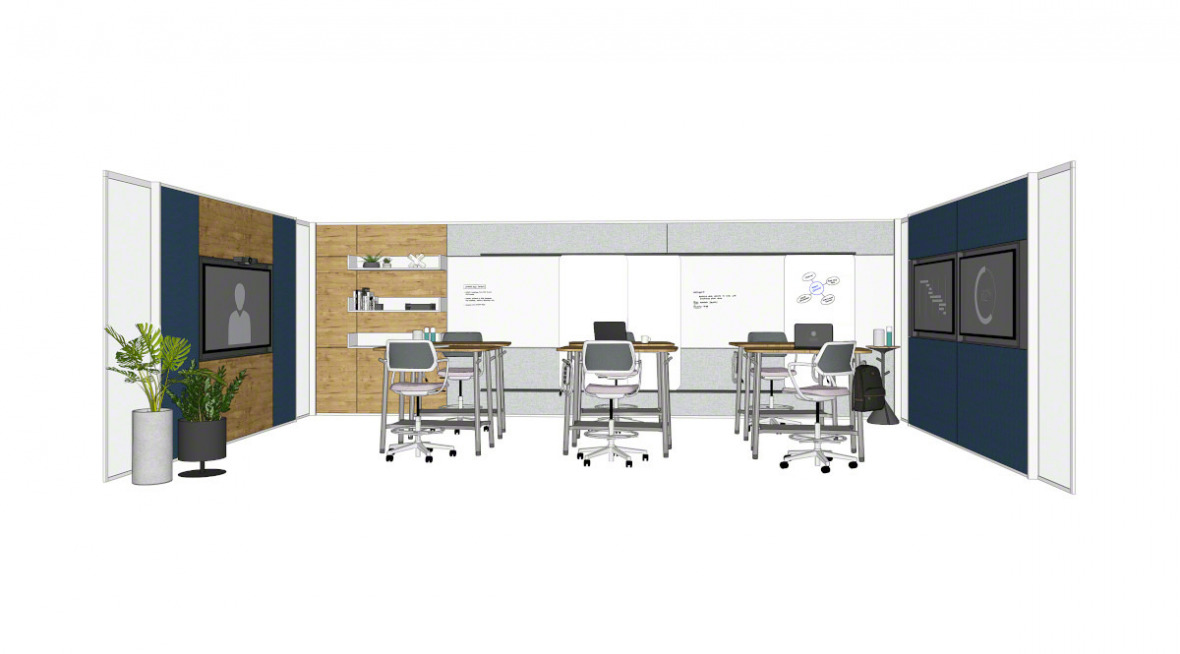We use cookies to make this site as useful as possible and maximize your experience. By closing this message, you consent to our cookies on this device in accordance with our cookie policy unless you have disabled them in your browser settings.
Examples of Teamwork in the Workplace

Setting the Stage for Examples of Teamwork in the Workplace
Lights, Camera… Audio, Content
To increase a hybrid work experience, it is critical that a company’s leader thinks like a director. The technology that supports remote work is similar to a production set. It requires high-quality visuals, audio, displays, and content in order to successfully meet the needs of the audience. These elements are the backbone of hybrid culture and are strong examples of teamwork and collaboration in the workplace. It also lays the foundation for learning, communication, and action amongst in-office and remote employees.
Visual Examples of Collaboration and Teamwork
Setting up an aesthetically pleasing virtual space is beneficial for all participants. Clear visuals and ambient lighting invites everyone to fully engage, making this a vital element in setting the stage for success. There are three components that make up visual technology: camera, display, and lighting.
- Camera: To begin, examine the relationship of the physical space and camera. For a smaller space, it requires a smaller field of view; for a larger space, it requires a larger field of view. Rather than calculating this yourself, an auto-framing camera adjusts the field of view automatically by monitoring the movement of the participants and number of people in the audience. There are additional features such as manual zoom, auto-tracking, auto-image correction, and much more to support the needs of remote participants.
- Display: Display design helps participants collaborate, engage, and digest information. A user having two displays with supported hardware is optimal for participation. It allows them to separate people and content that is being displayed. In addition, the size and quality of the monitor determine how close a participant has to sit the screen. To make sure they are sitting at a comfortable distance, opt for a larger screen and higher resolution.
- Lighting: You can have the best camera and display, but without proper lighting, it would be irrelevant. It is important to illuminate the participant’s face through an overhead ambient light at a 45-degree angle. In addition, avoid backlighting (such as windows) because that will overshadow the participant. If this is unavoidable, utilize window treatments to minimize the light.
Audio Teamwork in the Workplace Examples
Audio, which can also be categorized as communication, is the premise of meetings. It is the foundation that generates brainstorming, feedback, and clear action to take a company’s next step. To support this critical teamwork, quality acoustics, microphones, and speakers are needed.
- Acoustics: The space sets the tone for acoustics. For example, a large room that has a marble floor and minimal furniture echoes when someone speaks (which is not ideal when speaking to someone virtually). Finding or creating an acoustically calibrated space enhances sound. Select rooms that are smaller, have carpet and furniture, and, if available, acoustic-absorbing wall panels to help mitigate the excess sound waves.
- Microphone: Make sure all participant’s voices can be heard, but within reason. Avoid distracting background noise by onboarding noise suppression software. This technology is customizable to the user and can be adjusted as needed. For optimal sound, virtual microphones are a great option; however, these should be used with caution as they pick up the quietest whispers.
- Speakers: Recommended speakers are dependent on the space and audience. Group settings require higher watts and more speakers, while peer-to-peer meetings call for audio spotlights. Audio spotlights convey clear sound to the user but minimal sound to the surrounding areas. This is a great option for collaborative workspaces that host various virtual meetings at once. In addition, there are platforms that automate transcripts of meetings and language translators to make sure the message has been effectively conveyed to everyone.
Content Examples of Collaboration in the Workplace
Enhance hybrid engagement through shared collaboration tools. Using digital and analog tools keeps all parties fully engaged in the task at hand. It is encouraged to onboard a variety of tools to give individuals choice and control regarding which tools work best for them.
- Smart Whiteboards: These enable co-creation for remote and in-office teams. The software can track the physical content being created and replicate it digitally for virtual participants.
- Content Cameras: These cameras are designed to capture analog content and produce increased readability for the virtual audience.
- Digital Content Creation: What was once done physically, can now be done digitally. Sticky notes, shapes, and digital whiteboard collaboration are available through software.
Are you ready to set the stage for your digital needs? Contact us today at (858) 569-4700 or complete this contact form to receive a FREE risk assessment and floor plan analysis.
